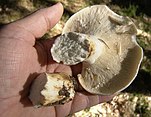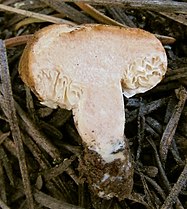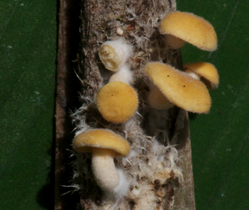Russulaceae
| Russulaceae | |
|---|---|

| |
| Russula emetica | |
| Scientific classification | |
| Domain: | Eukaryota |
| Kingdom: | Fungi |
| Division: | Basidiomycota |
| Class: | Agaricomycetes |
| Order: | Russulales |
| Family: | Russulaceae Lotsy (1907)[1] |
| Type genus | |
| Russula Pers. (1796) | |
| Genera | |
1including Arcangeliella, Gastrolactarius, and Zelleromyces | |
| Synonyms[2][3] | |
| |
The Russulaceae are a diverse
.In addition to these typical agaricoid forms, the family contains species with fruitbodies that are laterally striped (pleurotoid), closed (secotioid or gasteroid), or crust-like (corticioid). Molecular phylogenetics has demonstrated close affinities between species with very different fruitbody types and has discovered new, distinct lineages.
An important group of root-
Systematics and taxonomy
The family Russulaceae was first
Placement of the family
Historically, the
Internal systematics
| Phylogeny of the Russulaceae; dashed lines indicate uncertain placement.[10][13][14][15] |
A 2008 molecular phylogenetic study clarified the relationships among the mushroom-forming species of the family.[15] The authors demonstrated the existence of four distinct lineages of gilled mushrooms, which led to the description of Multifurca as a new genus separated from Russula[15] and the segregation of Lactifluus from Lactarius.[16][17]
Genera with closed fruitbodies within the family are form taxa instead of natural groups: Arcangeliella, Gastrolactarius, and Zelleromyces are phylogenetically part of Lactarius, while Cystangium, Elasmomyces, Gymnomyces, Macowanites, and Martellia belong to Russula.[3][16] Nevertheless, some of these genus names are still in use, as many of the concerned species have not yet formally been synonymised with Lactarius or Russula.[18]
The crust-like genera
Species diversity
Altogether, the Russulaceae comprise around 1,900 accepted species.[18] Russula is by far the largest genus with c. 1100 species, Lactarius has c. 550, Lactifluus c. 120, Boidinia 13, Multifurca 6, Gloeopeniophorella 6, and Pseudoxenasma 1 species.[18][19] Closed-fruitbody species not yet synonymised with Lactarius or Russula (see above) account for some 150 species.[18]
New species in the Russulaceae continue to be described from various regions, such as the US,
Description
Macroscopic characteristics
Three major types of
The agaricoid species in Lactarius, Lactifluus, Multifurca, and Russula are readily distinguished from other gilled mushrooms by the consistency of their flesh, which is granular, brittle and breaks easily, somewhat like a piece of chalk.[1][30] Russulaceae never have a volva,[30] but a partial veil can be found in some tropical species.[31][32] Gills are adnate to decurrent, and the colour of the spore print ranges from white to ochre or orange[15][33] (with the brown-spored Lactarius chromospermus as an exception[34]).
Caps can be dull to very colourful, the latter especially in Russula;[33] their size ranges from 17 mm diameter or less in Russula campinensis[35] to 30 cm (12 in) in Lactifluus vellereus.[33] Concentrically ringed (zonate) caps occur in all Multifurca[15] and several Lactarius species.[33] Laterally striped (pleurotoid) fruitbodies exist in some, mainly tropical Lactifluus and Russula species.[35][36][37][38] Taste is a distinguishing characteristic in many species, from mild to very acrid.[33] A conspicuous feature of the "milk-caps" in Lactarius, Lactifluus, and Multifurca furcata is the latex or "milk" their fruitbodies exude when bruised.[15][30]
The secotioid and gasteroid species in Lactarius and Russula are derived from agaricoid forms.
The corticioid species of Boidinia, Gloeopeniophorella, and Pseudoxenasma develop crust-like fruitbodies with a smooth, porous, or flaky surface and grow on tree logs or dead branches.[10][41][42][43]
|
| *These species belong phylogenetically to Lactarius. |
Microscopic characteristics
All Russulaceae, including the corticioid species, are characterised by spherical to elliptic
Characteristic cells with an oily content (gloeocystidia) are found in the hymenium. In Russulaceae, these show a positive colour reaction when treated with sulfoaldehydes (sulfovanillin is mostly used).[10][30] They are also present in the hyphal sheath of ectomycorrhizal roots colonised by Russulaceae.[14]
The feature responsible for the brittle fruitbody structure in the mushroom-forming species are globular cells, called sphaerocytes or sphaerocysts, that compose the flesh (trama) alongside the usual hyphae.[30] Sometimes, these cells are clustered, and the position and arrangement of these clusters differs among genera.[30]
Another particular trama cell type are lactiferous hyphae (also lactifers). These are hyphae carrying the "milk" or "latex" exuded by the
Genera distinction
Some characteristics of the mushroom-forming genera (marked with * below) can be less obvious or absent in tropical species.
- Boidinia: corticioid; loose texture; surface smooth, with pores, or flaky; spores spherical with spiny to warty ornamentation.[10][41] Note that the genus is polyphyletic and needs to be redefined.[10]
- Gloeopeniophorella: corticioid; surface almost smooth; hyphae without clamp connections; thick-walled cystidia (metuloids) and gloeocystidia present; spores with wrinkled (rugose) ornamentation.[43]
- Lactifluus: agaricoid or pleurotoid; exuding latex*; caps never zonate, viscose or glutinate, but sometimes annulate; thick-walled cells in cap and stipe cuticles; often sphaerocytes in the gill trama.[15][17]
- Multifurca: agaricoid; caps zonate (also visible in cut through trama); gills regularly forked; only M. furcata exuding latex; spore print orange; spores very small; microscopical trama and hymenium features very variable.[15]
- Pseudoxenasma: corticioid; wax-like texture; gloeocystidia with spherical apical appendices; basidia developing laterally on hyphae (pleurobasidia); spores broadly ellipsoid to roughly spherical, with warty ornamentation.[42]
- Russula: agaricoid, gasteroid or pleurotoid; never exuding latex; caps often brightly coloured with stipe and gills much paler; caps not zonate*; spore print white, cream, ochre, or orange; no true lactiferous hyphae*; sphaerocytes abundant in gill, cap, and stipe trama.[15][30]
Distribution
The Russulaceae as a whole have a worldwide distribution, but patterns differ among genera. Russula is the most widespread, found in North,[47][48] Central[49][50] and South America,[32][51] Europe,[33] temperate[52][53] and tropical Asia,[54][55] Africa,[56] and Australasia.[36][57][58] It is the only Russulaceae genus that occurs in the Nothofagus zone of temperate South America.[59]
Lactarius is mainly known from the north temperate zone, but some species also occur in tropical Asia and Africa.[17] Lactifluus has a more tropical distribution than Lactarius, with most species known from tropical Africa, Asia, South America, and Australasia, but some also occurring in the north temperate zone.[17] Multifurca is the rarest among the four mushroom genera, known only from some punctual records in North and Central America, Asia, and Australasia.[15][19]
Species of Lactarius, Lactifluus, and Russula have repeatedly been introduced with trees outside their native range: An overview article lists introductions in Chile, Argentina, Uruguay, Brazil, the US, Great Britain, the Faroe Islands, South Africa, China, Thailand, and New Zealand.[60]
Among the corticioid genera, Pseudoxenasma is only known from Europe.[61] In contrast, Boidinia species have been found in Europe,[62] Taiwan,[63] and Japan,[41] and Gloeopeniophorella species in North America,[64] South America,[43][65] Europe,[66] West Africa,[65] Taiwan,[63] Australia,[43] and New Zealand.[43]
Ecology
Ectomycorrhizal symbiosis
The genera Lactarius, Lactifluus, Multifurca and Russula form a mutualistic ectomycorrhizal root symbiosis with trees and shrubs, exchanging mineral nutrients for photosynthetic sugar. They are one of several fungal lineages that have evolved such a lifestyle and are sometimes referred to as the "/russula-lactarius" clade in the scientific literature.[67] Worldwide, they are one of the most frequently encountered lineages on ectomycorrhizal roots.[68] While some tropical species were initially believed to be parasitic, the observation that species fruiting on tree trunks do form ectomycorrhiza in tropical Guyana supports the view of an exclusively symbiotic lineage.[35]
Associations are known with several plant families. In the Northern Hemisphere, these are essentially the well-known ectomycorrhizal trees and shrubs in the
The different plant partners are reflected in the wide variety of habitats worldwide.
Other types of mycorrhiza
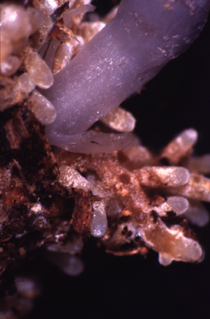
Some of the ectomycorrhizal Russulaceae are also involved in other types of root symbioses with plants.
A mutualistic association similar to ectomycorrhiza but with some hyphae penetrating into the plant root cells, termed
Some Russulaceae are associated with
Russulaceae are also an important group of orchid mycorrhizal fungi.[94] This symbiosis is mutualistic in the case of green orchids,[89] but a partly or fully epiparasitic relationship in the case of myco-heterotrophic[95][96] and mixotrophic[97] orchids, respectively. In some cases, the association with Russulaceae is, as in monotropoid mycorrhiza, very specific: the Mediterranean orchid Limodorum abortivum predominantly associates with Russula delica and closely related species;[97] in Corallorhiza maculata, different genotypes of the same species have distinct Russula partners.[95]
Wood decay species
The corticioid species in Boidinia, Gloeopeniophorella, and Pseudoxenasma are
Hypogeous fruiting
Hypogeous fruitbodies, or fruitbodies developing below ground, occur in Lactarius and Russula and have previously been considered as distinct genera (see Systematics and taxonomy: Internal systematics). As such species are especially diverse in some warm and dry regions, e.g. in Spain,[3] California,[98] or Australia,[57] below-ground fruiting has been interpreted as an adaptation to drought.[39] However, hypogeous Russulaceae are also known from cold temperate regions[23][99] and tropical rainforest.[25] The fact that hypogeous species in the Russulaceae do not form their own lineages but are scattered in Russula or Lactarius shows that this type of fruiting evolved several times.[25] It is believed that these changes are evolutionarily quite recent.[25]
Parasites
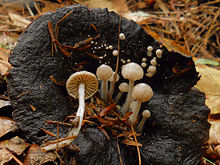
Russulaceae fruitbodies are subject to
Threats and conservation
As with most fungi,[101] little information is available on the threat of extinction for Russulaceae species, and they have not been assessed in the International Union for the Conservation of Nature's Red List.[102] However, national lists contain some species of Lactarius, Lactifluus and Russula, indicating that they have small populations and are endangered, e.g. in Great Britain,[103] Switzerland,[104] the Czech Republic,[105] and New Zealand.[106]
Although data on Russulaceae themselves are scarce, more is known about the habitats they occur in, especially for the ectomycorrhizal species which depend on their host plants: Several of these habitats are affected by loss or degradation, such as peatlands,[107] Mediterranean forests and scrub[108] or tropical African dry woodland.[109] Similarly, dead wood, the habitat of the corticioid Russulaceae, is rare in many exploited forests and needs special management.[110]
Recent studies have found some traditional Russulaceae species to comprise several cryptic species (see Systematics and taxonomy: Species diversity). This may imply that distribution range and population size for each of such distinct species are smaller than previously thought.[111]
Edibility

Several species of Lactarius, Lactifluus and Russula are valued as excellent edible mushrooms. This is the case for example for the north temperate species Lactarius deliciosus, Lactifluus volemus, or Russula vesca, and other species are popular in other parts of the world, e.g. Lactarius indigo in Mexico, or Lactifluus edulis in tropical Africa.[112] Some species, like Russula vesca, can even be eaten raw.[113] The brittle texture of Russula fruitbodies makes them different from other mushrooms and is not appreciated by some.[114]
Several species have a hot to very acrid taste and can cause
Cultivation of edible Russulaceae, as in other ectomycorrhizal fungi, is challenging, since the presence of host trees is required. In spite of this difficulty, the European Lactarius deliciosus has been successfully grown in "mushroom orchards" in New Zealand.[122]
Chemistry

Fruitbodies of Russulaceae have been the subject of natural product research, and different classes of organic compounds have been isolated from them.
Other metabolites isolated from different species include dibenzonaphtyridinone
References
- ^ a b c Lotsy JP (1907). Vorträge über botanische Stammesgeschichte [Lectures on botanical phylogeny, held at the Imperial University of Leiden] (in German). Jena, Germany: Gustav Fischer. pp. 708.

- ^ .
- ^ a b c d e Calonge FD, Martín MP (2000). "Morphological and molecular data on the taxonomy of Gymnomyces, Martellia and Zelleromyces (Elasmomycetaceae, Russulales)" (PDF). Mycotaxon. 76: 9–15.

- ^ a b "Russulaceae Lotsy, Truffe, ed. 2: 708 (1907)". MycoBank. International Mycological Association. Retrieved 2014-12-28.
- .
- ^ McNeill J, Barrie FR, Buck WR, Demoulin V, eds. (2012). "Article 18.4". International Code of Nomenclature for algae, fungi, and plants (Melbourne Code), adopted by the Eighteenth International Botanical Congress Melbourne, Australia, July 2011 (electronic ed.). Bratislava: International Association for Plant Taxonomy.

- ISBN 978-3-87429-254-2.
- OCLC 139485.
- ISBN 978-3-437-30262-6.
- ^ PMID 21149013.

- ISBN 978-3-540-58008-9.
- S2CID 4686378. Archived from the original(PDF) on 2009-03-26.
- ^ PMID 17981020.
- ^ PMID 17486972.
- ^ a b c d e f g h i j k l m n Buyck B, Hofstetter V, Eberhardt U, Verbeken A, Kauff F (2008). "Walking the thin line between Russula and Lactarius: The dilemma of Russula sect. Ochricompactae" (PDF). Fungal Diversity. 28: 15–40.
- ^ doi:10.1002/tax.591031.

- ^ a b c d e f Verbeken A, Nuytinck J (2013). "Not every milkcap is a Lactarius" (PDF). Scripta Botanica Belgica. 51: 162–168.
- ^ a b c d e Kirk PM. "Species Fungorum (version October 2014). In: Species 2000 & ITIS Catalogue of Life". Species 2000 & ITIS. Archived from the original on 2020-05-13. Retrieved 2014-10-30.
- ^ S2CID 15230777.
- ISSN 1937-786X.

- doi:10.5248/121.233.
- .
- ^ S2CID 9078246.
- PMID 25083405.

- ^ PMID 25264381.

- ^ Vellinga EC (2013). "The North American Mycoflora Project: Without a sequenced specimen it is a rumor". McIlvainea (22): V22/north_american_mycoflora.html.

- S2CID 25615396.
- S2CID 18795528.
- ^ "Contrasting evolutionary patterns in two sister genera of macrofungi: Lactarius and Lactifluus". Ghent University. Archived from the original on 2014-10-06. Retrieved 2014-10-10.
- ^ a b c d e f g h i j "Russulales News / Characteristics of the russuloid fungi". Museo delle scienze. Retrieved 2014-11-01.
- ^ Heim R (1938). "Diagnoses latines d'espèces et variétés nouvelles de Lactario-russulés du domaine oriental de Madagascar [Latin diagnoses for new species and varieties of Lactario-Russulas from the Eastern domain of Madagascar]". Candollea (in French and Latin). 7: 374–393.
- ^ a b Singer R, Aurajuo I, Ivory MH (1983). "The ectotrophically mycorrhizal fungi of the neotropical lowlands, especially central Amazonia". Beihefte zur Nova Hedwigia: 1–352.
- ^ ISBN 978-2-603-02038-8.
- ^ Buyck B, Verbeken A (1995). "Studies in tropical African Lactarius species, 2: Lactarius chromospermus Pegler". Mycotaxon. 56: 427–442.
- ^ S2CID 84487967.
- ^ JSTOR 3761355.
- S2CID 86083157.
- ^ Morozova OV, Popov ES, Kovalenko AE (2013). "Studies on mycobiota of Vietnam. II. Two new species of Lactifluus (Russulaceae) with pleurotoid basidiomata" (PDF). Mikologia I Fitopatologia. 47 (2): 92–102.
- ^ JSTOR 3792830.
- ^ PMID 21156601.

- ^ a b c Maekawa N (1994). "Taxonomic study of Japanese Corticiaceae (Aphyllophoraceae) II". Report of the Tottori Mycological Institute. 32: 1–123.
- ^ a b Hjortstam K, Larsson KH (1976). "Pseudoxenasma, a new genus of Corticiaceae (Basidiomycetes)". Mycotaxon. 4 (1): 307–311.
- ^ a b c d e Hjortstam K, Ryvarden L (2007). "Studies in corticioid fungi from Venezuela III (Basidiomycotina, Aphyllophorales)". Synopsis Fungorum. 23: 56–107. Archived from the original on 2016-02-03. Retrieved 2014-12-14.
- ISBN 978-0-85199-827-5.
- ISBN 978-0-88902-977-4.
- ^ ISBN 978-0-8156-0388-7.
- JSTOR 40594086.

- JSTOR 40594096.

- ^ Gómez-Pignataro LD, Alfaro RM (1996). "Basidiomicetes de Costa Rica. De Russulae novae". Revista de Biología Tropical (in Spanish and English). 44 (Suppl. 4): 25–37. Archived from the original on 2016-04-28. Retrieved 2014-12-14.

- PMID 21156563.

- ^ Sá MC, Baseia IG, Wartchow F (2013). "Checklist of Russulaceae from Brazil" (PDF). Mycotaxon. online 125: 303.

- ^ a b Guo J, Karunarathna SC, Mortimer PE, Xu J, Hyde KD (2014). "Phylogenetic diversity of Russula from Xiaozhongdian, Yunnan, China, inferred from Internal Transcribed Spacer sequence data". Chiang Mai Journal of Science. 41 (4): 811–821.
- S2CID 18397587.
- S2CID 35051818.
- ^ a b c Natarajan KN, Senthilarasu G, Kumaresan V, Rivière T (2005). "Diversity in ectomycorrhizal fungi of a dipterocarp forest in Western Ghats" (PDF). Current Science. 88 (12): 1893–1895. Archived from the original (PDF) on 2016-03-04. Retrieved 2014-12-14.

- ^ a b Verbeken A, Buyck B (2002). "Diversity and ecology of tropical ectomycorrhizal fungi in Africa" (PDF). In Watling R, Frankland JC, Ainsworth AM, Isaac S, Robinson CH (eds.). Tropical Mycology: Macromycetes. Wallingford, UK: CAB International. pp. 11–21. Archived from the original (PDF) on 2014-10-06.

- ^ ISBN 978-1-86320-167-4.

- ^
- ^ JSTOR 4547770.
- PMID 19170899.

- ^ "Pseudoxenasma verrucisporum". Global Biodiversity Information Facility (GBIF). Retrieved 2014-11-20.
- ISBN 978-88-901057-9-1.
- ^ a b Wu SH (1996). "Studies on Gloeocystidiellum sensu lato (Basidiomycotina) in Taiwan". Mycotaxon. 58: 1–68.
- ^ Ginns J, Freeman GW (1994). "The Gloeocystidiellaceae (Basidiomycota, Hericiales) of North America". Bibliotheca Mycologica. 157: 1–118.
- ^ a b Boidin J, Lanquetin P, Gilles G (1997). "Le genre Gloeocystidiellum sensu lato (Basidiomycotina)". Bulletin de la Société Mycologique de France (in French). 113 (1): 1–80.
- ^ Eriksson J, Ryvarden L (1975). The Corticiaceae of North Europe. Vol. 3. Oslo: Fungiflora.
- ^ "UNITE database: EcM genera and lineages". University of Tartu. Archived from the original on 2014-10-25. Retrieved 2014-10-25.
- PMID 20088976.

- ^
- PMID 20012655.

- doi:10.1139/b02-082.
- ^ ISBN 978-2-7099-1684-4.
- PMID 15720703.

- ^ PMID 19956273.

- PMID 18371004.

- S2CID 14575220.
- ^
- ^ PMID 18631297.

- ^ S2CID 195074078. Archived from the original(PDF) on 2016-03-04.
- ^ "Russulales News / Where do we find Russulales?". Museo delle scienze. Retrieved 2014-11-01.
- PMID 16684245.

- ^ Thormann MN, Rice AV (2007). "Fungi from peatlands" (PDF). Fungal Diversity. 24: 241–299.
- ^ S2CID 2799893.

- ^ Halling RE, Mueller GM. "Agarics and boletes of neotropical oakwoods" (PDF). In Watling R, Frankland JC, Ainsworth AM, Isaac S, Robinson CH (eds.). Tropical Mycology: Macromycetes. Wallingford, UK: CAB International. pp. 1–10. Archived from the original (PDF) on 2014-10-07.

- S2CID 14185353.
- ^ Miller OK, Hilton RN (1986). "New and interesting agarics from Western Australia" (PDF). Sydowia. 39: 126–137.
- .
- ^ Chalermpongse A. (1995). The occurrence and use of ectomycorrhizal fungi in eucalypt plantations in Thailand. In ACIAR PROCEEDINGS (PDF). Canberra: Australian Centre for International Agricultural Research. pp. 127–131.

- ^ ISBN 978-0-12-370526-6.
- ^ S2CID 86309482.
- ^ S2CID 4244284.
- ^ PMID 15998389.

- S2CID 39886589.

- S2CID 6199725.
- ^ PMID 15002769.

- PMID 19682351.

- ^ S2CID 40474597.
- PMID 16769510.
- JSTOR 20794526.
- ^ "The Global Fungal Red List Initiative". International Union for Conservation of Nature (IUCN). Retrieved 2014-11-16.
- ^ "The IUCN Red List of Threatened Species. Version 2014.3". International Union for Conservation of Nature (IUCN). Archived from the original on 2014-06-27. Retrieved 2014-11-15.
- ^ Evans S, Henrici A, Ing B (2006). "Red Data List of Threatened British Fungi" (PDF). British Mycological Society. Archived from the original (PDF) on 2014-12-14.
- ^ Senn-Irlet B, Bieri G, Egli S (2007). Rote Liste der gefährdeten Grosspilze der Schweiz [Red list of endangered macromycetes of Switzerland] (PDF) (in German). Bern; Birmensdorf: Bundesamt für Umwelt & WSL.

- ISSN 1211-3603.
- ^ "Nationally Critical: Rare and endangered fungi". Landcare Research. Retrieved 2014-11-15.
- ISBN 978-0-85198-998-3.
- S2CID 84365927.
- .
- doi:10.14214/sf.390.

- PMID 17129636.
- ^ "Russulales News / Edibility and toxicity of Russulales". Museo delle scienze. Retrieved 2014-12-13.
- ISBN 978-0-584-10324-3.
- ISBN 978-0-89815-169-5.
- ISBN 978-0-7627-3109-1.
- ^ Veteläinen M, Huldén M, Pehu T (2008). State of plant genetic resources for food and agriculture in Finland. Second Finnish National Report (PDF). Country Report on the State of Plant Genetic Resources for Food and Agriculture (Report). Sastamala, Finland: Ministry of Agriculture and Forestry. p. 14.
- ISBN 978-0-253-21210-8.
- ISBN 978-0-226-17719-9.
- ISBN 978-0-9781358-1-2.
- S2CID 5341127.
- ^ .
- S2CID 13077838.
- JSTOR 3761565.
- .
- S2CID 21207966.
- .
- ISBN 978-92-893-2705-3.
- ^ )
- .
- PMID 7856401.
- PMID 11324907.
- ^ Bourquelot E (1889). "Sur la volémite, nouvelle matière sucrée" [On volémite, a new sweet substance]. Journal de Pharmacie et de Chimie (in French). 2: 385–390.
- PMID 19465932.
- PMID 19481130.
- PMID 20378319.

